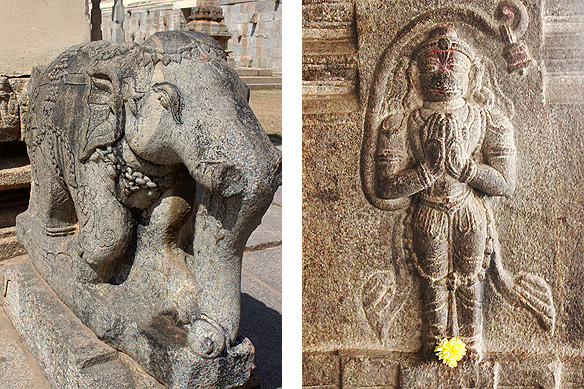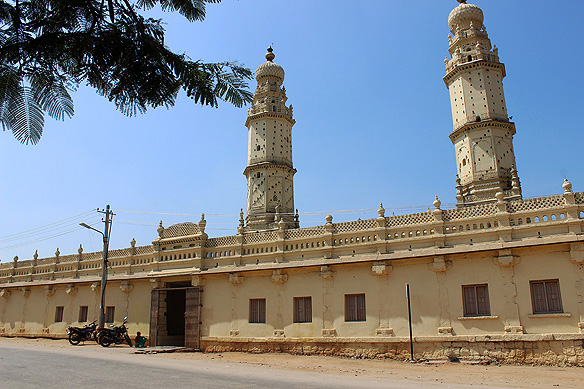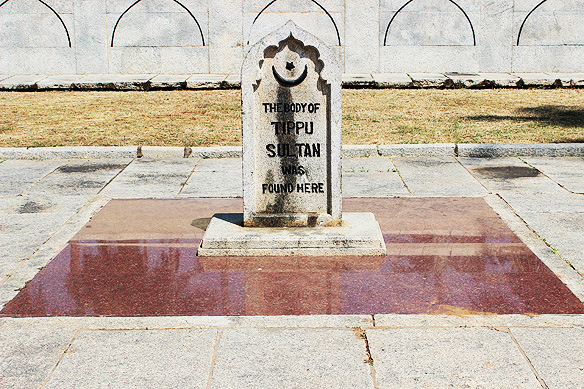
Some 18.5 kilometres to the north-east of Mysore city, on an island called Srirangapatna, lies a dusty town lost in time. Its current worn state belies its glorious past which still reveals itself shyly from behind its weathered structures.
Key historical events have taken place on its softly undulating plains. Larger than life rulers who till date evoke strong emotions made the island the centre of their universe.
Welcome to my guide on Srirangapatna, capital of the 18th Century ruler Tipu Sultan aka the Tiger of Mysore. The Why, What, Where, When and How guide of a town well off the usual tourist circuit, but deeply ingrained in every Indian history book, mass media, world museums and private collections.
[Note: Top image: Detail, Fourth Anglo-Mysore War, 4 May 1799, British East India Company painting.]
First questions first. So, why does Srirangapatna need to be on your bucket list?
If you are an Indophile, and love all things Indian, especially Indian history, Srirangapatna will strike just the right chord with you. Every lane and monument scattered over the little island recounts the feats of one of India’s most famous, yet controversial, heroes: Tipu Sultan, the 18th Century ruler of the Kingdom of Mysore who put up a string of four wars to deter the British East India Company from making inroads into India.
But if the convolutions of Indian history leave you a tad dizzy, and it is the attractions of the West which you relate to better, Srirangapatna still appeals. Remember the mind-boggling, exotic, life-size toy tiger in the Victoria and Albert Museum, London, and the golden slippers and floral tent in the Clive Museum, Wales? Or the Huma Bird in the Royal Collection Trust and the exotic jewel-encrusted throne finial in the Met Museum, New York. They all belonged to the same fearless warrior-king.
This island on the sacred Cauvery river in the heart of Karnataka is where Tipu’s sumptuous home was, where he ruled from, where he strategized and fought his legendary battles at, where he breathed his last in a befitting hero’s death, and where he lies buried along with his parents under a tiger-patterned dome.
After his death, the British Generals stripped his city, home and body of its staggering wealth. They took everything that they could lay their hands on and was possible to be shipped back home. Though the treasures are now long gone and lie in various museums and private collections in Britain and elsewhere, the 250-year-old monuments still stand.
Weathered and worn, their glories are intact for those who like to travel the path less travelled. Srirangapatna is where tourists are rare, and those looking for stories in its structures are more. Does that second group sound like you? If yes, do read on. 🙂


Srirangapatna is named after the above 10th Century Ranganathaswamy Temple, a sacred pilgrimage site for Vaishnavites [Vishnu followers]. Tipu Sultan made huge donations to the temple during his reign; its chief priest was his astrologer.
What are Srirangapatna’s not-to-be-missed treasures?
Now that you have decided to visit this historical gem, the next question would be: What is there to explore? As usual, there are the obvious attractions and then the not-so-obvious, kind-of-hidden-away attractions. The happy part is that Srirangapatna is small enough to explore them all on a day’s excursion.
A good place to start is the sacred pilgrimage site of Ranganathaswamy Temple, from which Srirangapatna derives its name. The temple is dedicated to Ranganatha, one of the manifestations of Vishnu, and dates back to 984 AD during the Ganga period. Various dynasties have added to its gorgeousness over the following centuries. Deep in the inner sanctum is a reclining Vishnu on the coils of the snake Adisesha. His consort Lakshmi stands by his feet.
The Tipu Connection? His astrologer was a priest in the temple. Because of this, the Sultan is said to have made huge donations to it.
Refrain from using your camera to take pictures in the inner sanctum though, or you may well have one of the elderly priests blast out at you in impeccable English “This is a temple, not a monument. Put that camera away!”
Next in the itinerary would be the 250-year-old ethereal Dariya Daulat Bagh or the ‘Garden of the Sea of Wealth’ surrounded by nondescript lawns that conceal the treasures inside. Historical murals fill the teak wood structure to the brim. Walls, ceilings, columns—every inch inside the palace recounts historical events [2nd Mysore War] and animated courtly life, interspersed with lush floral patterns.
A small, well-curated museum reveals fascinating insights into Tipu Sultan’s life and character through his personal belongings [such as silk trousers] and sketches of his sons by Company artists. Tipu Sultan had the palace built in 1784 as his Summer Palace and spent many an Indian summer inside its cool, colourful walls with his family.
Why it was not destroyed like everything else in 1799 by the British East India Company, post his defeat, is because Colonel Arthur Wellesley [later the Duke of Wellington] took a liking to the palace and decided to stay there himself.
At the eastern end of the island is Gumbaz [or on google map: Tippu Sultan Shaheed Rahmatullah Alaih], Tipu Sultan’s burial place. It is a lovely edifice in the Persian style flanked by the Masjid-E-Aksa mosque. Tipu lies buried in the mausoleum with his dad Hyder Ali and mom Fakr-Un-Nisa under a ceiling painted with tiger stripes.
The 20-metre-high, black granite and amphibolite mausoleum in the centre of a cypress garden was built by Tipu in 1782 – 84 to house his parent’s graves. After his own death in the Siege of Srirangapatna [4th May, 1799], his corpse was buried next to them in a hurried move by the Company.
Another Indian treasure, now in the Victoria and Albert Museum, London, are the original carved doors which once stood at the mausoleum’s entrance. The present ebony embedded with ivory doors are Lord Dalhousie’s gift to Srirangapatna in 1855. Still beautiful enough. Dalhousie was also responsible for the restoration of Dariya Daulat Bagh that same year.
These three sites will take up most of your time during your day excursion. And it is for good reason. They are exquisite.
Short pit stops to enhance the Tipu Sultan experience lie scattered in between these three and are recommended. Between Ranganathaswamy Temple and Dariya Daulat Bagh are the ruins of Lal Mahal, his full-fledged palace which was destroyed during the Siege in 1799. A short distance away from the palace is the iconic, still functioning, Jumma Mosque with its towering minarets and walls embellished with scores of niches. Another remnant of Tipu Sultan’s rule, it was built by him in 1787.
But Mr. Sultan was no angel. He was rich and fearless. And equally heartless, as illustrated by the number of dungeons all over the island. Thomas Inman’s Dungeon is where Maratha invaders and other Indian prisoners were held captive during Hyder Ali and Tipu Sultan’s rule. Colonel Bailey’s Dungeon housed British prisoners and is named after the prisoner Colonel Bailey who died in its callous depths in 1780.
The exact site where Tipu Sultan himself met his own death, despite having the opportunity to escape, is marked with a marker. It reads as follows:
“In the fourth Mysore War the British laid siege to Srirangapatna on 4th May 1799 AD and effectively breached the Fort at Watergate. On hearing of this storming of the enemy, Tipu moved posthaste to the spot, and in the fight, fell to the bullet of a British soldier. It was here the body of Tipu Sultan was identified and recovered amidst heaps of the dead soldiers. In recognition of the valiant Tipu, Colonel Wellesley set a stone tablet to mark the spot.”
Tipu Sultan’s life is what books and movies are made of. It is a long time since he is gone, but he is still remembered with strong opinions. Srirangapatna’s sites help to humanise the legend in a significant way.

Dariya Daulat Bagh, Tipu Sultan’s Summer Palace [1784] is filled with murals depicting scenes from the recently won 2nd Anglo-Mysore War [1780 – 84]. Here, he is seen in conversation with his commander-in-chief Kamuruddin during a war procession.

Splendid painted stucco and Tipu Sultan’s signature striped pillars decorate the large airy halls in Dariya Daulat Bagh.


Top: Dariya Daulat Bagh’s entire eastern wall is a heady array of Tip Sultan’s contemporaries. Above: Courtier receiving guests in his home, eastern wall. Just look at their costumes and expressions!

Sketch of one of Tipu Sultan’s 12 sons by a British East India Company artist.
Where exactly is Srirangapatna?
Srirangapatna is 18.5 kilometres to the north-east of Mysore. In Indian road travel terms this translates to a 30-minute drive.

Mysore thali, my driver Zabu’s lunch—delectable and photogenic. I, on the other hand, had a prosaic plate of French fries and filter coffee. Where? Nalpak Restaurant across the road from Tipu Sultan’s Summer Palace.


This charming Jumma [Friday] Mosque, decorated with geometric lines composed of niches, was built by Tipu Sultan in 1787. Above left: A classroom in the madrasah inside.
When is the best time to visit Srirangapatna?
October to February are the recommended travel months for most destinations in South India. Srirangapatna is no different. The weather is comparatively mild and the sun is not scorching as it otherwise is.

During Hyder Ali and Tipu Sultan’s rule, Maratha invaders and other Indian prisoners were held captive in the Thomas Inman’s Dungeon. The dungeon is named after the British gentleman who ‘discovered’ its existence in 1895 in the north-east corner of the Fort.

A marker indicates the exact spot where Tipu Sultan was gunned down by the British East India Company soldiers on 4th May, 1799.
How do I reach and explore this little gem?
The best bet is to hire a day taxi [for convenience] or an auto [for atmosphere]. I had got myself a car and driver from Fox Travels and it was pretty perfect.


Gumbaz, Tipu Sultan’s final resting place where he lies next to his parents, Hyder Ali and Fakr-Un-Nisa. The edifice is pure poetry in the Persian Bijapur style; the tiger stripes inside the mausoleum a solemn yet fiery ode to the ‘Tiger of Mysore’s’ bravery.

Hope you enjoyed this guide.
Wishing you happy virtual travels [under the current COVID-19 circumstances]. Keep virtual travelling. Keep learning. Keep growing. ❤
You may also like to read:
Why Tipu Sultan’s Dariya Daulat Bagh will take your breath away
– – –
[Note: This blog post is part of a series from my solo and independent travel to Mysore and its surrounds over 5 days in end-January 2020. To read more posts on Karnataka, click here.]

I first went there in 1978. I have a photo of the mausoleum but can’t remember much else.
LikeLiked by 1 person
Wow. 1978! Please do share the picture. I would love to see it. If you have it on your blog please let me know the link. If not, could you mail the picture to me at rama.arya@gmail.com? Thanks in advance. 🙂
LikeLike
I’ll look it out. Obv not digital, a slide transparency which I will scan
LikeLiked by 1 person
Thank you. 🙂
LikeLike
Check my blog, Rama Arya
LikeLiked by 1 person
Beautiful picture!
LikeLike
And here’s a link to some scanned transparencies taken by me in India, mainly in 1978
LikeLiked by 1 person
Please share the link.
LikeLike
And another link to more photos of my travels in India in 1978 and again a few years later.
LikeLike
Very strange, the links don’t come through on WordPress. Look at your email
LikeLike
Yeah, it seems WordPress removes links. Thanks for the mails. I went through both the sets. Absolutely loved the photos. I moved back to India in 2011 and for me, your pics give an insight into an India I never got to experience. Thank you super much for sharing them with me. 🙂
LikeLike
In the new book The Anarchy, William Darmphyle mentioned three battles that shaped the history of The East India Company and the British rule in India, eventually. One of them was the battle with Tipu Sultan. Such was the stature of his empire. It is a shame that many of the prized possessions of Tipu Sultan are lying in museums overseas. Thanks for this detailed guide, Rama.
LikeLiked by 1 person
As some wise person once said: Travel is the best classroom. 🙂
LikeLiked by 1 person
True.
LikeLike
Nice.. had been here last year. Please do check out my blog too @: https://travelrahul.wordpress.com/ also
LikeLiked by 1 person
Hello Rahul, did you write about Srirangapatna? I could not find the post. If you did, do share the exact link. I see you went to Kruger. I used to live in South Africa. Its a stunning country. One of the most beautiful in the world. 🙂
LikeLiked by 1 person
Hi Rama, I did not write a post about my visit to Srirangapatna yet. Yeah, South Africa is my favorite country which I have visited till date… Cool to know that you were living there! Please follow me for more travel related content. Thank you!
LikeLiked by 1 person